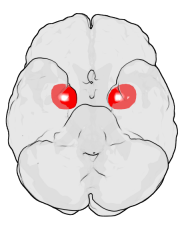
Photo from wikipedia
The basolateral amygdala (BLA) controls numerous behaviors, like anxiety and reward seeking, via the activity of glutamatergic principal neurons. These BLA neurons receive excitatory inputs primarily via two major anatomical… Click to show full abstract
The basolateral amygdala (BLA) controls numerous behaviors, like anxiety and reward seeking, via the activity of glutamatergic principal neurons. These BLA neurons receive excitatory inputs primarily via two major anatomical pathways - the external capsule (EC), which contains afferents from lateral cortical structures, and the stria terminalis (ST), containing synapses from more midline brain structures. Chronic intermittent ethanol (CIE) exposure/withdrawal produces distinct alterations in these pathways. Specifically, 10 days of CIE (via vapor inhalation) increases presynaptic function at ST synapses and postsynaptic function at EC synapses. Given that 10-day CIE/withdrawal also increases anxiety-like behavior, we sought to examine the development of these alterations at these inputs using an exposure time-course in both male and female rats. Specifically, using 3, 7, and 10 days CIE exposure, we found that all three durations increase anxiety-like behavior in the elevated plus maze. At BLA synapses, increased presynaptic function at ST inputs required shorter exposure durations relative to post-synaptic alterations at EC inputs in both sexes. But, synaptic alterations in females required longer ethanol exposures compared to males. These data suggest that presynaptic alteration at ST-BLA afferents is an early neuroadaptation during repeated ethanol exposures. And, the similar patterns of presynaptic-then-postsynaptic facilitation across the sexes suggest the former may be required for the latter. These cooperative interactions may contribute to the increased anxiety-like behavior that is observed following CIE-induced withdrawal and may provide novel therapeutic targets to reverse withdrawal-induced anxiety.
Journal Title: Neuroscience
Year Published: 2018
Link to full text (if available)
Share on Social Media: Sign Up to like & get
recommendations!